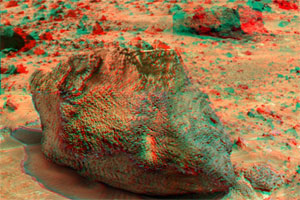 3-D anaglyph technology was used in the generation of this photo of taken in 1997 by the Mars Pathfinder. Photo courtesy of NASA/JPL-Caltech.In 1952, movie makers, wincing in the face of an erosion of revenue lost to the onset of television, unveiled Bwana Devil, the first 3-D color film ever experienced by a mass audience. The film, based on the story of the Tsavo maneaters, two lions that developed a taste for human flesh in Uganda in 1898 (think: The Ghost and the Darkness minus good acting and subtlety), was lambasted almost universally by the critics. Time Magazine's Bosley Crowther denounced it as "a clumsy try at an African adventure film, photographed in very poor color in what appear to be the California hills." The Saturday Review's Hollis Alpert wrote, "It is the worst movie in my rather faltering memory, and my hangover from it was so painful that I immediately went to see a two-dimensional movie for relief."
3-D anaglyph technology was used in the generation of this photo of taken in 1997 by the Mars Pathfinder. Photo courtesy of NASA/JPL-Caltech.In 1952, movie makers, wincing in the face of an erosion of revenue lost to the onset of television, unveiled Bwana Devil, the first 3-D color film ever experienced by a mass audience. The film, based on the story of the Tsavo maneaters, two lions that developed a taste for human flesh in Uganda in 1898 (think: The Ghost and the Darkness minus good acting and subtlety), was lambasted almost universally by the critics. Time Magazine's Bosley Crowther denounced it as "a clumsy try at an African adventure film, photographed in very poor color in what appear to be the California hills." The Saturday Review's Hollis Alpert wrote, "It is the worst movie in my rather faltering memory, and my hangover from it was so painful that I immediately went to see a two-dimensional movie for relief."
Regardless, the public flocked back to the theaters in droves. A spat of 3-D pictures followed, sucking in everyone from John Wayne to Alfred Hitchcock (despite his own tepid feelings toward 3-D), and J.R. Eyerman immortalized the fad in a series of iconic black-and-white prints. Ultimately, however, the phenomenon was short-lived.
3-D films have come back with a bang, most recently with Harry Potter's domination of airwaves, subway ads, and bus station billboards in anticipation of The Half-Blood Prince. Whether here to stay in film this time or another passing fad, 3-D technology will remain both a fascinating technology and valuable tool in science.
Ideas and techniques for generating a 3-D illusion from 2-D panels date as far back as the mid 1800s, and are grounded theoretically on parallax. Parallax is what you see when you look out sideways from the window of a car or bus, and you see trees and buildings in the foreground whizzing by much faster than the mountains in the background. If you trick your eyes into looking at two different images as opposed to just one, for example by crossing them, then you can exploit parallax and trick yourself into seeing depth in a 2-D picture.
Keeping a person's eyes constantly crossed may be difficult for fixed images. For feature length films, it would be nearly impossible, but this is where those funky glasses come in. Modern films and almost all of the 1950s 3-D films rely on polarized light. Light waves may be visualized for many purposes by shaking the end of a jump rope. Shaking vertically makes vertical polarization, and shaking horizontally makes horizontal polarization. A polarized light projector, coupled with the appropriate glasses, ensures that one eye sees only horizontally polarized light while the other eye sees only vertically polarized light. Modern projectors employ the slight modification of using left-handed and right-handed circularly polarized light, which allows people to maintain a 3-D viewing experience with tilted heads (try this the next time you visit a 3-D film!), but the basic concept is the same.
